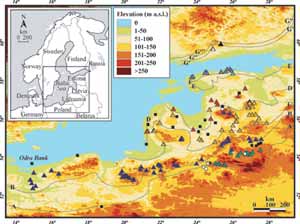2:00 p.m. Eastern, March 20, 2006 — Move over, Superman, with your X-ray vision. Marine scientists have now figured out a way to “see through” the ocean’s surface and detect what’s below, with the help of satellites in space.
Using sensor data from several U.S. and European satellites, researchers from the University of Delaware, NASA’s Jet Propulsion Laboratory, and the Ocean University of China have developed a method to detect super-salty, submerged eddies cal
The Mediterranean looks better in the dark – at least in the view of an ESA-led effort to use satellites to take the daily temperature of Europe’s seas. A switch to data acquired at night is one of several improvements undertaken to enhance reliability and reach of Medspiration project outputs.
With sea surface temperature (SST) an important variable for weather and ocean forecasting – and increasingly seen as a key indicator of climate change – the concept behind Medspiration
Scientists have confirmed that climate warming is changing how much water remains locked in the Antarctic and Greenland ice sheets, according to an article published in the Journal of Glaciology.
Using radar altimeter data from ESA’s ERS-1 and ERS-2, Jay Zwally, a scientist at NASA’s Goddard Space Flight Center, and his colleagues mapped the height of the ice sheets and found there was a net loss of ice from the combined sheets between 1992 and 2002 and a corresponding rise
Imagine a space tool so revolutionary it can determine the impact of climate change, monitor the melting of glaciers, discover invisible waves, predict the strength of hurricanes, conserve fish stocks and measure river and lake levels worldwide, among other scientific applications. This instrument is not the subject of a science-fiction novel. In fact, four of them are already operating 800 kilometres above Earth.
Fifteen years ago this ground-breaking instrument, called a radar altimeter,
Findings could increase popular compound’s therapeutic use and effectiveness
According to the study, these activators bind to specific sites on the neurotoxin protein, increasing protease activity and enhancing the toxin’s effect. In some cases, the study noted, the activation power of the new molecules was as much as fourteen-fold, the greatest increase in activation ever reported for a protease; before this study, a two-fold activation of a protease was referred to

Behavior of Scandinavian Ice Sheet at the end of the last Ice Age may preview loss of Greenland Ice Sheet due to global warming
The retreat of a massive ice sheet that once covered much of northern Europe has been described for the first time, and researchers believe it may provide a sneak preview of how present-day ice sheets in Greenland and Antarctica will act in the face of global warming.
The study, which appears in the current issue of the journal Science, was led